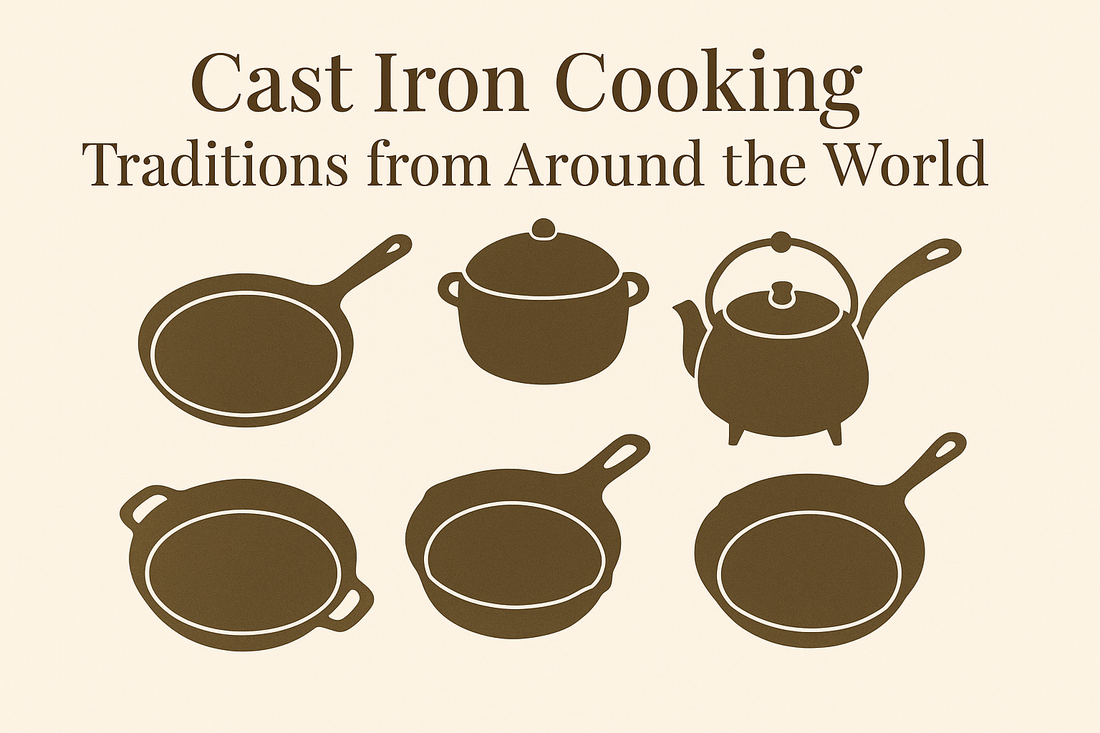Cast Iron Cooking Traditions from Around the World

Cast iron isn’t just an American kitchen staple—it’s a global tradition. From sizzling flatbreads in India to simmering tagines in North Africa, cultures around the world have embraced cast iron for centuries. Its unmatched heat retention, rugged durability, and ability to go from stovetop to fire pit have made it a universal tool for cooks across continents.
In this post, we’ll explore how cast iron cookware is used in different culinary traditions and why it remains a vital part of kitchens worldwide.
Africa: Tagines and Three-Legged Pots
In North and West Africa, cast iron takes on various forms beyond the familiar skillet. One of the most well-known is the tagine—a cast or clay pot with a conical lid used to slow-cook stews over coals. In southern Africa, traditional potjie pots are three-legged cast iron cauldrons that rest directly over fire, often used for communal stews and gatherings.
These pieces are often seasoned with oil just like Western skillets, and the patina built over time is considered part of the cooking tradition.
Asia: Woks and Tawas
While carbon steel woks are common in Chinese cooking, cast iron woks are prized for their heat retention and stability—especially for stir-frying meats and vegetables that need high, even heat.
In India, the tawa—a flat or slightly concave cast iron griddle—is used daily for making roti, paratha, and dosas. Many Indian families pass down tawas from generation to generation, with the flavor and seasoning improving over time.
Europe: Dutch Ovens and Griddles
Europe brought us one of the most iconic cast iron tools: the Dutch oven. Originating from the Netherlands and popularized in England and colonial America, the Dutch oven is a lidded cast iron pot perfect for baking bread, braising meats, and making stews.
In France, the cast iron tradition was refined with enameled cookware from brands like Le Creuset—combining beauty with function while still maintaining the integrity of cast iron.
Latin America: Comales and Arepa Pans
Across Mexico and Central America, the comal—a flat cast iron or clay griddle—is used to cook tortillas, roast chilies, and toast spices. In Colombia and Venezuela, cast iron pans are used for making arepas, with deep ridges and durable walls perfect for pressing and grilling the thick corn patties.
The intense, dry heat cast iron provides is ideal for the crispy textures and roasted flavors that define many Latin dishes.
United States: Skillets That Tell Stories
In the U.S., cast iron became a household staple in the 1800s. Families cooked over wood-burning stoves and open fires using simple, uncoated skillets passed down through generations. Fried chicken, cornbread, biscuits, and bacon all carry the signature crust and flavor that only seasoned cast iron can deliver.
Modern American brands and enthusiasts are reviving traditional cast iron methods—favoring hand-poured, American-made products that stay true to the legacy of durable, no-frills cookware.
Why Cast Iron Connects Cultures
No matter where you look, cast iron cookware is more than just a kitchen tool—it’s part of the culture. Its consistent performance and timeless reliability have made it a fixture from rural villages to urban restaurants.
Across all these cultures, three values remain constant:
-
Simplicity: No electronics, no coatings—just fire, iron, and time.
-
Durability: Cast iron lasts decades, often improving with each use.
-
Tradition: Whether it’s bread, stew, or flatbread, the method and memory stay with the cookware.
Conclusion
Cast iron cookware tells a story—of heritage, tradition, and flavor. Whether you're flipping tortillas on a comal or slow-roasting lamb in a Dutch oven, you're participating in a global legacy of cast iron cooking.
Next time you reach for your skillet, remember: you’re cooking with the same timeless material trusted in kitchens around the world.
No comments






0 comments